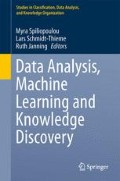Abstract
Feature extraction methods are widely applied in order to reduce the dimensionality of data for subsequent classification, thus decreasing the risk of noise fitting. Principal Component Analysis (PCA) is a popular linear method for transforming high-dimensional data into a low-dimensional representation. Non-linear and non-parametric methods for dimension reduction, such as Isomap, Stochastic Neighbor Embedding (SNE) and Interpol are also used. In this study, we compare the performance of PCA, Isomap, t-SNE and Interpol as preprocessing steps for classification of protein sequences. Using random forests, we compared the classification performance on two artificial and eighteen real-world protein data sets, including HIV drug resistance, HIV-1 co-receptor usage and protein functional class prediction, preprocessed with PCA, Isomap, t-SNE and Interpol. Significant differences between these feature extraction methods were observed. The prediction performance of Interpol converges towards a stable and significantly higher value compared to PCA, Isomap and t-SNE. This is probably due to the nature of protein sequences, where amino acid are often dependent from and affect each other to achieve, for instance, conformational stability. However, visualization of data reduced with Interpol is rather unintuitive, compared to the other methods. We conclude that Interpol is superior to PCA, Isomap and t-SNE for feature extraction previous to classification, but is of limited use for visualization.
Access this chapter
Tax calculation will be finalised at checkout
Purchases are for personal use only
References
Breiman, L. (2001). Random forests. Machine Learning, 45, 5–32.
Cai, C. Z., Han, L. Y., Ji, Z. L., Chen, X., & Chen, Y. Z. (2003). SVM-Prot: Web-based support vector machinee software for functional classification of a protein from its primary sequence. Nucleic Acids Research, 31, 459–462.
Caruana, R., & Niculescu-Mizil, A. (2006). An empirical comparison of supervised learning algorithms. In Proceedings of the 23rd International Conference on Machine Learning, Pittsburgh, PA.
Cox, T. F., Cox, M. A. A., & Raton, B. (2003). Multidimensional scaling. Technometrics, 45(2), 182.
Dybowski, J. N., Heider, D., & Hoffmann, D. (2010). Prediction of co-receptor usage of HIV-1 from genotype. PLOS Computational Biology, 6(4), e1000743.
Dybowski, J. N., Riemenschneider, M., Hauke, S., Pyka, M., Verheyen, J., Hoffmann, D., et al. (2011). Improved Bevirimat resistance prediction by combination of structural and sequence-based classifiers. BioData Mining, 4, 26.
Heider, D., Appelmann, J., Bayro, T., Dreckmann, W., Held, A., Winkler, J., et al. (2009). A computational approach for the identification of small GTPases based on preprocessed amino acid sequences. Technology in Cancer Research and Treatment, 8(5), 333–342.
Heider, D., Hauke, S., Pyka, M., & Kessler, D. (2010). Insights into the classification of small GTPases. Advances and Applications in Bioinformatics and Chemistry, 3, 15–24.
Heider, D., & Hoffmann, D. (2011). Interpol: An R package for preprocessing of protein sequences. BioData Mining, 4, 16.
Jolliffe, I. T. (2002). Principal component analysis (2nd ed.). Springer series in statistics. New York: Springer.
Kyte, J., & Doolittle, R. (1982). A simple method for displaying the hydropathic character of a protein. Journal of Molecular Biology, 157, 105–132.
Nanni, L., & Lumini, A. (2011). A new encoding technique for peptide classification. Expert Systems with Applications, 38(4), 3185–3191.
Rhee, S. Y., Taylor, J., Wadhera, G., Ben-Hur, A., Brutlag, D. L., & Shafer, R. W. (2006). Genotypic predictors of human immunodeficiency virus type 1 drug resistance. Proceedings of the National Academy of Sciences of USA, 103(46), 17355–17360.
Tenenbaum, J. B., De Silva, V., & Langford, J. C. (2000). A global geometric framework for nonlinear dimensionality reduction. Science, 290(5500), 2319–2323.
van der Maaten, L., & Hinton, G. (2008). Visualizing high-dimensional data using t-SNE. Journal of Machine Learning Research, 9, 2579–2605.
Author information
Authors and Affiliations
Corresponding author
Editor information
Editors and Affiliations
Rights and permissions
Copyright information
© 2014 Springer International Publishing Switzerland
About this paper
Cite this paper
Heider, D., Bartenhagen, C., Dybowski, J.N., Hauke, S., Pyka, M., Hoffmann, D. (2014). Unsupervised Dimension Reduction Methods for Protein Sequence Classification. In: Spiliopoulou, M., Schmidt-Thieme, L., Janning, R. (eds) Data Analysis, Machine Learning and Knowledge Discovery. Studies in Classification, Data Analysis, and Knowledge Organization. Springer, Cham. https://doi.org/10.1007/978-3-319-01595-8_32
Download citation
DOI: https://doi.org/10.1007/978-3-319-01595-8_32
Published:
Publisher Name: Springer, Cham
Print ISBN: 978-3-319-01594-1
Online ISBN: 978-3-319-01595-8
eBook Packages: Mathematics and StatisticsMathematics and Statistics (R0)

